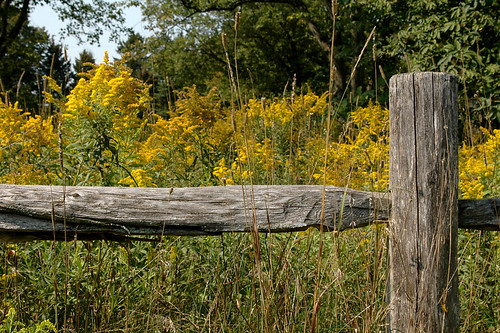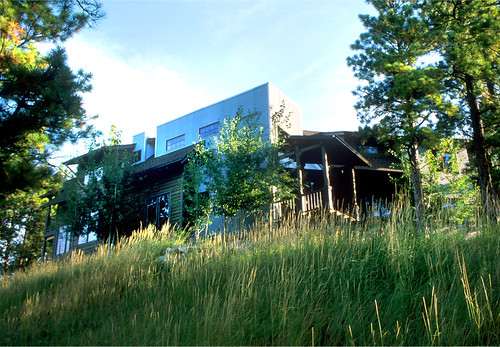Sowing a Native Grass Lawn
After a long hiatus from blogging about landscape design and sustainable landscaping, I want to try to get back into blogging about Waterwise Gardening and the like -- after all, this is how I make my living (not by blogging, but by creating landscape designs...)
I subscribe to a weekly email newsletter from SantaFe Greenhouses in New Mexico. Last year, they published an excellent article on sowing a native grass meadow and now that it's spring again, I am reminded that a native grass lawn or meadow is probably one of the best ways to deal with the "deer browse" problem many of my clients ask me about.

Gleaming meadow, originally uploaded by Linda6769.
Linda has so many gorgeous photos of wildflower meadows, grasses and ferns on her Flickr site. Check out her other meadowish pics. And thank you, Linda for letting me blog your photo here.

October Meadow, originally uploaded by jimfrazier.
Thank you Jim for allowing me to use your photo for this blog post.
Southwest Gardens and their partner company High Country Gardens, have several seed mixes formulated for them, one of which would be ideal to sow native grass meadows in the part of Montana where I live, in growing zone 4 with cold winters and dry summers.
Native Grass Species in Mix
- Blue grama, Hachita (Bouteloua gracilis) 15%
- Little bluestem, Blaze (Schizachyrium scoparium) 10%
- Indian ricegrass, Rimrock (Achnatherum hymenoides) 10%
- Sideoats grama, El Reno (Bouteloua curtipendula) 15%
- Galleta, Viva (Pleuraphis jamesii) 5%
- Alkali sacaton, VNS (Sporobolus airoides) 5%
- Western wheatgrass, Arriba (Pascopyrum smithii) 5%
- Sand dropseed, VNS (Sporobolus cryptandrus) 5%
- Buffalo grass, Texoca (Buchloe dactyloides) 10%
- Sheep fescue, Covar (Festuca ovina) 10%
- Green needlegrass, Lodorm (Nassella viridula) 5%
- Perennial ryegrass, Linn (Lolium perenne) Nurse crop 5%
Although some of the grasses in the list above are not native to my area, after calling and inquiring about the mix, I learned that even if they don't all germinate, a meadow sown from this mix will settle out to a "natural" balance of grasses, a subset of the above mix, with the hardy ones thriving and the non-hardies simply failing to return.

Goldenrod and Fencepost, originally uploaded by jimfrazier.
Here are some articles from High Country Gardens specifically about Native Grass Lawns (that one has a bit about interspersing a few perennials in with the grasses for a colorful lawn.) Other articles are available on planting a Blue Gamma grass lawn from seed (Blue gramma grass is a low-maintenance, low-water lawn alternative) and waterwise lawns.
I have to caution you before you dive into a native grass meadow or lawn project, that of the remarks my past customers have made is that native grass lawns tend to look "weedy" or unkempt after awhile. This may happen if you don't get out and mow more often than the 2 times per season I recommend. Also, when the grasses are very tall, their height obscures any lower growing plants in the meadow, or in surrounding plant beds (plants like Oakleaf Sumac, Potentilla, dwarf pines and perennial wildflowers.) A solution to that problem is to plant only short-grass native grasses, so that you can "let the meadow go" but it will not get out of hand, height-wise. Read about a low-maintenance, waterwise native grass lawn at High Country Gardens where they sell a Dwarf Fescue seed for native lawns. The dwarf fescue stays short (under 12 inches) naturally, therefore it's a lower maintenance natural-lawn alternative.
Even if you don't live in New Mexico, the Santa Fe Greenhouses e-newsletter is extremely informative and inspiring. To subscribe to their excellent newsletter by email, click here. They also have their past newsletters archived, so check it out.




















2 Comments:
I didn't know you were a landscape designer. That explains a few things. (Like your amazing flora photography.)
I gave up on my flowerbeds a few years ago, after too many struggles with deer, earwigs and hauling water. But a few have managed to hang on -- crocuses, lavender, sagebrush.
ahhh, patia -- there are actually some things deer don't really like to eat unless they are hungry or young and curious and don't know better. Sagebrush, lavender and russian sage happen to be on the list
lots of nurseries handl out lists of supposedly "deer -resistant" plants. Don't believe 'em! There is almost no such thing. they'll taste anything - even daffodils, which are toxic to the deer. I've seen them go along an uproot a whole line of daffodils, leaving the plants and blossoms just lying crushed on the ground. just tasting, mam.
well, if i ever get together with you in mizzoo, we'll have to see about your flowerbeds. maybe there is something else you could do to deter the deer and earwigs. Don't know if I can help you avoid hauling a certain amount of water, though. heh!
btw - looks like a new "icon" for you. You are looking great!
Post a Comment